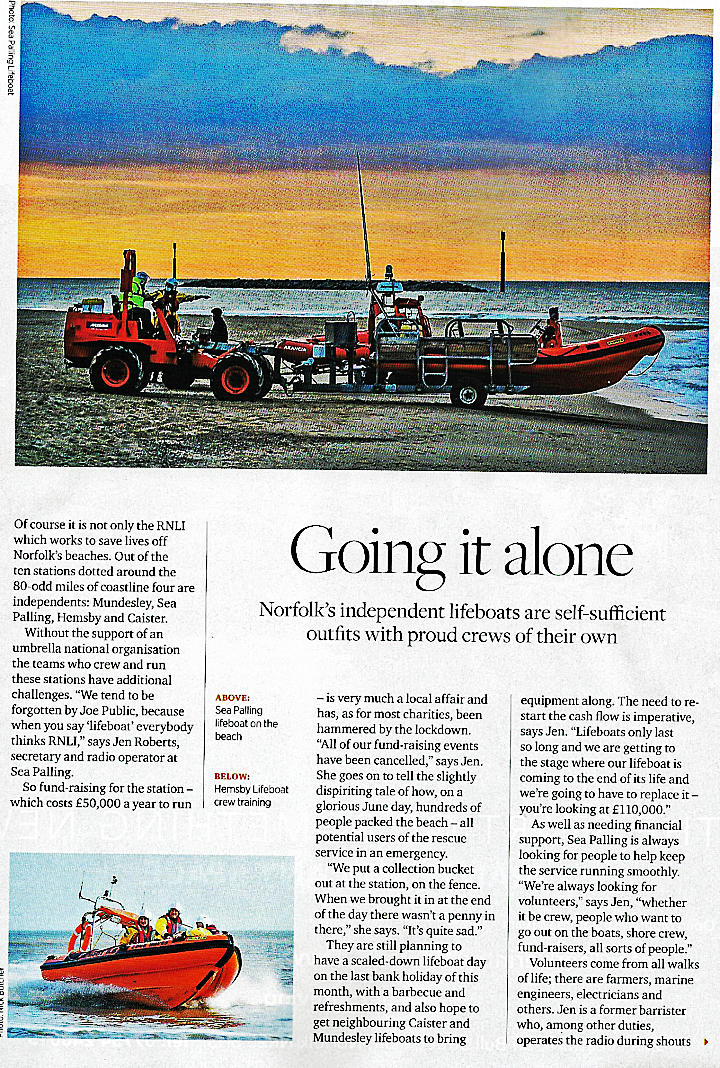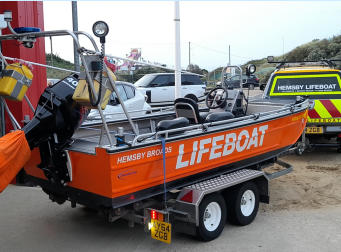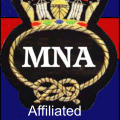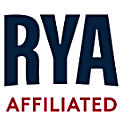
INDEPENDENT LIFEBOATS

Hemsby Independent Lifeboat Station
Hemsby Independent Lifeboat Service came fully into service in 1977 following
the formation of the Hemsby Volunteer Inshore Rescue Club in 1976 as a result
of their having been nine fatalities as a result of drowning in the previous four
years along the popular local North Sea beaches.
The Hemsby Lifeboat Service is especially notable as a result of its role in
covering a very significant area of the Norfolk Broads as well as the nearby
Norfolk beaches; in fact well over 50% of the call-outs for the Hemsby boats are
in response to incidents on The Broads rather than to those at sea and one of
the two (soon to be three) Hemsby Lifeboats is designated as “The Broads
Lifeboat” and this well-equipped Dory style lifeboat can be towed by a dedicated
Hemsby Lifeboat Station vehicle to no less than thirty two launching sites
around the Broads.
It’s self-evident therefore that Hemsby Lifeboat Station is of very significant
importance and value to members of the NSBA, and indeed to anyone engaged
in boating activities on The Broads
However it is this very towing vehicle, which is virtually identical to those used by
the Coastguard Rescue Teams, that has recently become a “cause celebre” for
those of us involved in maritime Search & Rescue because, as a result of a
complaint by a member of the public, the Hemsby Lifeboat Station has been
informed by the Police that because the their Lifeboat is independent of the RNLI
they are NOT authorised to tow their boat to call-outs using a blue light and/or
two-tone horns (known to most of us a “blues ‘n twos”
As things stand the Police are quite correct as regards stating that under current
regulations only lifeboats belonging to the RNLI are allowed to use “blues ‘n
twos” so Clive Edwards, as the NSBA’s representative on the Broads Authority’s
Boat Safety Management Group, and as Commodore of the Merchant Navy
Association Boat Club’s WaterWatch maritime safety scheme, suggested that the
Chairman of the NSBA should write to the Minister of Transport to seek a change to the regulations that would enable
independent lifeboat stations to use “blues ‘n twos” in the same way that RNLI lifeboat stations are authorised to
.Backing for this initiative by the NSBA, the MNA Boat Club and the Institute of Seamanship has been forthcoming from
several other organisations involved in maritime safety including from the Broads Authority and the National Independent
Lifeboat Association, and the response from the Ministry of Transport has been encouraging at least in so as far as saying that
they “have the question under review and that a decision about the use of Blue Lights is likely to be made by September of
this year” Let’s hope that the decision is a positive one because there have already been delays in the response time taken
to get the Hemsby Lifeboat to launching sites because of the towing vehicle being unnecessarily held up in traffic that would
normally have not impeded the passage of an emergency vehicle operating Blues & Twos
Before recommending to the NSBA management committee that the NSBA
Chairman should make representation to the Minister about this restriction
imposed on Hemsby and other independent lifeboat stations I took the
opportunity to make two visits to the Hemsby station. I was made very welcome
by both Daniel Hurd their cox’n and their Secretary Chris Batten who took a lot
of trouble to show me around the station, lifeboats, vehicles and other SAR
assets which were as impressive as any I’ve seen elsewhere in literally dozens
of visits to (mainly RNLI) lifeboat stations. On my second visit I was
accompanied by the former Lifeboat Operations Manager of an RNLI station on
the south coast who said he wishes his local lifeboat station was as modern and
well equipped as Hemsby!
So, on behalf of the Merchant Navy Assn. Boat Club as an affiliated member of
the NSBA I wish the Hemsby Station well, not only with their quest to be treated
the same as RNLI stations as regards the use of “blues ‘n twos” but also
because, as many of you will have seen on TV during last winter, Hemsby village and the lifeboat station suffered huge storm
damage with several properties being washed into the sea. Whilst the lifeboat station itself was safe the slipway was largely
washed away and their 7.5m ILB could no longer be launched from the station!
Clive Edwards, MIoS
Commodore MNA Boat Club




The NILA is a charity that was formed in 2022 to promote and support independent lifeboat organisations across the United
Kingdom.
NILA’s mission is to give a voice, assistance and advice to the growing community of independent lifeboats across the United
Kingdom, creating a valued, professional and recognised resource for water-based search and rescue.
The NILA community has a shared vision and values, providing an opportunity for collaborative development and training while
allowing members to retain their independence.
For more information visit their website - click here.
National Independent Lifeboat Association (NILA)


Full history here
Merchant Navy Association Boat Club
(Affiliated to the Merchant Navy Association National Charity)
A Case for ‘Blues ‘n Twos’
The Lifeboat for the Broads
The story of the “Lifeboat for the Broads” began in 1999 following a call from
Great Yarmouth Coastguard requesting the inshore inflatable lifeboat stationed
on the coast at Hemsby to attend an incident several miles inland on Hickling
Broad.
The Hemsby crew responded of course even though this meant having to tow
the lifeboat, courtesy of a local farmer, several miles by road to a launching slip
at Hickling Broad.
Although that was the first recorded incident of Hemsby Lifeboat being tasked
by the Coastguard to attend an incident on the Broads, the history of Hemsby
Lifeboat station itself actually began many years previously in the early 1970s
following more than a dozen fatalities as a result of drowning along the coastal
waters between Winterton and Scratby where the nearest lifeboats were an
RNLI “D” class 5m inflatable at Happisburgh to the north and an old Liverpool
Class all weather lifeboat capable of no more than about 8 knots based at
Caister to the south.
The result of these drownings was a commitment in 1975 by the local Hemsby community to form a local Rescue Service and to
source an appropriate “rescue boat” in the shape of a 4.5m Avon inflatable on loan from the Sub Aqua club. Later that year,
thanks to the generosity of the Norfolk Broads Lions Club, the Hemsby Inshore Rescue Service (HIRS) was able to purchase its
own boat, a 5m Avon Searider RIB with a 40hp Mercury outboard, appropriately named “Sealion 1” in recognition of the Lions
Club’s support.
Following the purchase of their own rescue boat there was the need to source a boat-house to keep it in at a site that enabled it
to be launched as quickly as possible in the event of an incident It was also necessary to equip the boat with essential kit such
as life-jackets, VHF radio etc and to recruit volunteers to act as crew.
This in turn led to the need to provide training in seamanship, radio
communications and first-aid for the boat and shore crews who initially
numbered around thirty volunteers. In their first year the Hemsby inshore
rescue service responded to six incidents (nowadays usually referred to as
“shouts”)
The next years, 1977 and 1978, were busy with all the administrative measures
required to obtain recognition by the Charity Commission and HM Coastguard
plus operational matters such as the purchase of a Land Rover for launching
the boat and pagers for the crew. During that same two-year period the HIRS
responded to no less than 19 “shouts”
The1980s saw many developments amongst the most significant being the
official recognition by HM Coastguard of Hemsby IRS as a “Declared Facility”
and an integral part of the UK Search & Rescue organisation (UKSAR)
Declared Facility Status, or DFS as it is usually referred to, is not only an
accolade that is hard to achieve but also requires the station to conform to the Coastguard Code of Practice covering its range of
operations and procedures, all of which are monitored annually by the Maritime & Coastguard Agency (MCA)
Other notable events during the 1980s and ‘90s included the building of a new lifeboat station and the purchase of three new
boats, Sealions ll, 11l and lV. All this against a worrying background of coastal erosion.
During this time Hemsby Inshore Rescue Services responded to more than eighty “shouts” culminating in 1999 with the incident
described previously several miles inland on Hickling Broad. This incident lead to a decision to purchase a dedicated “freshwater
lifeboat” mainly for incidents on The Broads, where the usual RIB with its relatively deep hull designed for use at sea, is really not
best suited to the often quite shallow waters of the Broads.
The turn of the century saw the introduction of the first Hemsby Broads Rescue
Boat, subsequently superseded by similar types of boat culminating a few years
ago with a 14 foot Seastrike/Goodchild Marine very shallow draft aluminium
“dory” powered by a 30hp outboard normally towed to one of some 32 launching
sites around the 125 miles of the Broads by a Mitsubishi L20 tow truck
This Broads Rescue Boat, known more commonly as the Lifeboat for the Broads,
responds to an average of some 50 incidents every year. At the same time
Hemsby’s sea-going RIB lifeboat also gets numerous shouts for incidents
offshore, made more difficult in terms of launching by the serious and on-going
coastal erosion here which deserves far more from the government in terms of
improved sea defences. If this is not forthcoming there will be a need for the
whole Hemsby Lifeboat Station and its operations to be relocated.
The following is an example of the type of “shout” that the Hemsby Lifeboat for
the Broads responds to:
“Hemsby Broads Rescue was paged by Humber Coastguard last night at 23:40. Our assistance was requested by local
Coastguard teams to help with the evacuation of a female in her seventies who had fallen on her vessel earlier in the
evening.
It was agreed by the Coastguard and the medical team on scene that the best option would be to navigate the vessel to
a suitable mooring close to the Ambulance, as the alternative would have been a significant walk and not in the best
interests of the casualty or emergency crews.
We launched Broads Marley and, after locating the casualty vessel, put two crew on board to navigate to the selected
mooring close to the ambulance. Helmed by a lifeboat crew, the vessel proceeded under escort from the Broads
Rescue Boat and was safely repositioned.
We thank the Coastguard teams from Bacton and Winterton and the Ambulance Crew. Once the casualty was safe on
board the ambulance Hemsby Stood down and returned to base for post-emergency administration and clean down at
01:45.
Clive Edwards, MioS
November 2023





Typical ‘Shouts 2023’



